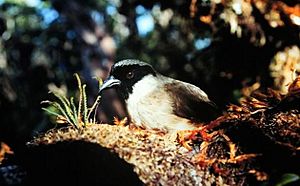Poʻouli facts for kids
Quick facts for kids Poʻo-uli |
|
|---|---|
 |
|
| Conservation status | |
| Scientific classification | |
| Genus: |
Melamprosops
|
| Species: |
phaeosoma
|
The poʻo-uli (Melamprosops phaeosoma), also known as the black-faced honeycreeper, was a special bird that lived only on the island of Maui in Hawaiʻi. It was a type of passerine bird, which means it was a perching bird. The poʻo-uli belonged to a group called Hawaiian honeycreepers. It was the only known member of its unique group, Melamprosops.
This bird had a black head, brown feathers on its back, and light gray feathers on its belly. It lived only in the drier, eastern part of Maui. Sadly, its numbers quickly dropped. People tried to catch the remaining birds to help them breed safely. However, these efforts were mostly unsuccessful. By 2004, only two poʻo-uli were known to be left. No more have been seen since then. In 2019, experts officially declared the poʻo-uli extinct.
Contents
About the Poʻo-uli
The poʻo-uli had a brown back and grayish-white belly. It had a wide black "mask" that went behind its eyes. Adult birds had silvery-gray feathers above this mask, which turned brown on top of their heads. They also had a light patch right behind the black mask. Young poʻo-uli looked similar but were more buff-colored underneath. They also had a smaller mask and no gray above it. Most pictures you see of the poʻo-uli are of young birds.
Discovery and Its Unique Family
The poʻo-uli was first found in 1973. Students from the University of Hawaiʻi discovered the bird. They found it on the slopes of Haleakalā on Maui, about 1,980 meters (6,500 feet) above sea level. This discovery was part of the Hana Rainforest Project.
The poʻo-uli was the first new Hawaiian honeycreeper species found since 1923. It looked very different from other Hawaiian birds. Scientists studied its DNA and believe it came from a very old line of Hawaiian honeycreepers. It seems to have been the last of its kind. No other living or fossil bird has a body structure like it.
What the Poʻo-uli Ate and Where It Lived
The poʻo-uli mostly ate snails, insects, and spiders. It built its nests in native ‘ōhi‘a lehua (Metrosideros polymorpha) forests.
Why the Poʻo-uli Disappeared
In the past, old fossils show that the poʻo-uli lived across the dry, southwestern side of Maui. It lived at lower elevations, from 275 to 1,350 meters (900 to 4,400 feet). Fossils suggest it ate native tree snails and insects.
However, a deadly disease called avian malaria arrived in Hawaii. This disease is carried by mosquitoes. It wiped out the poʻo-uli at lower elevations. This forced the birds to move to mountain rainforests. Their diet might have changed to mostly snails instead of insects.
When the poʻo-uli was first discovered, there were an estimated 100 to 200 birds. By 1981, there were only 15 birds per square kilometer. Just four years later, in 1985, there were only 8 birds per square kilometer. This means that in just ten years, from 1975 to 1985, the population dropped by over 90 percent. By the 1980s, the poʻo-uli was only found in a small area called the Hanawi Stream.
Efforts to Save the Poʻo-uli
To protect the poʻo-uli and other endangered plants and animals, the State of Hawaii created the Hanawi Natural Area Reserve. This reserve is about 9,500 acres (38 square kilometers). It connected several protected areas to make one large safe zone. Many groups worked together on this effort. These included the government, Maui County, the National Park Service, The Nature Conservancy, and private companies.
The land was fenced off, and by June 1996, they started removing wild pigs from the fenced areas. Four years later, after removing 202 pigs, the main area for the poʻo-uli was completely clear of pigs. As more pigs were removed from other areas, the numbers of native species like the Maui parrotbill and ʻākohekohe started to grow. Rats, cats, and goats were also removed from the poʻo-uli's habitat.
By 1997, only three poʻo-uli were known to be alive. They lived in the Hanawi Natural Area Reserve and the nearby Haleakalā National Park.
In 2002, one of these birds, a female, was caught. She was taken to where a male bird lived, hoping they would breed. However, the female flew back to her own territory, which was 1.5 miles (2.4 kilometers) away, by the next day. In 2004, there was another effort to save them. The goal was to catch all three birds and take them to a bird conservation center. This was done in the hope that they would have babies.
On September 9, 2004, one of the last birds, a male, was caught. He was taken to the Maui Bird Conservation Center in Olinda. Sadly, biologists could not find a mate for him before he died on November 26, 2004.
It is not known if the other two birds were a male and female, or both the same sex. Since 2004, many searches have been done, but no more poʻo-uli have been found. This means they are likely extinct. Tissue samples were taken from the male bird caught in 2004. These samples could be used for future research.
Many things led to the poʻo-uli's population dropping so quickly. These include:
- Loss of their habitat (the places they lived).
- Diseases carried by mosquitoes.
- Being hunted by animals like pigs, rats, cats, and small Asian mongooses.
- A decrease in the native tree snails they needed for food.
In 2019, after no sightings for a long time, and with their habitat still being damaged, the IUCN officially listed the poʻo-uli as Extinct.
See also
- In Spanish: Po'ouli para niños




